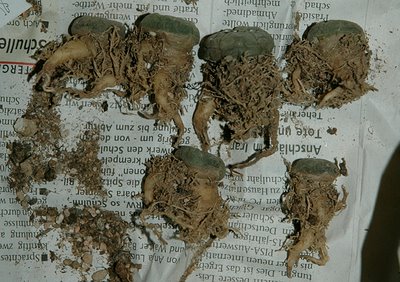For a while I’ve been searching for L. williamsii seeds and plants originating from Trans-Pecos, Texas. It’s been quite hard to find any – probably because of the legal status of Lophophora williamsii in the USA. Earlier this year I finally found a retailer selling plants originating from material collected in the Pecos River area, Val Verde County, Texas (JJH 8608293), and promptly ordered a handful of plants.

Lophophora williamsii, Pecos River, Val Verde Co.
The plants have been grown very hard and are of a high quality with good, sturdy roots; the width of the plants are in the range from 1.5 to 2.25 cm (0.6-0.9''). They were reasonably priced at 4 euro (~ 5 USD) each.
I recently received a second batch that I planned to grow in an unheated cold house, but I now have second thoughts and will probably postpone the cold house experiment until I’m able to propagate the plants from seed.
The plants were bought at Kakteen Kliem, a German retailer with a good selection of plants with locality information (I also bought some of his Lophophora fricii, Parras, Coahuila, Mexico (JJH 9602115) and Astrophytum asterias, Rio Grande City, Texas (PQ 91)). I would be glad to hear of any other sources of Trans-Pecos Lophophora with detailed locality information.
Malpighia 1927 v.30 (added: 11/24/2025)
-
*By:*
Borzi, Antonino,1852-1921.
Penzig, O.1856-1929.
Pirotta, Romualdo,1853-1936.
*Publication Info:*
Messina : g. Capra & co., 1887-89 ; Genova : Tip. di A...
5 weeks ago



















Are you proud of showing the looting of cacti in their lives? Just to fill your ego.
ReplyDeleteIgnorant, at least propagules and replanted where were taken.
Gringo plunderer, as your government
Ignorant? Plunderer? These plants are grown from seed in Europe and are not habitat collected, so I'm having a hard time seeing what your problem is. The fact that the plants come with locality information doesn't mean they have been looted from habitat - as the collection number indicates Josef J. Halda (JJH) collected seeds from a Lophophora williamsii population in the Pecos River area, Val Verde County, Texas in 1986. These seeds were propagated and the plants I bought originate from this material, seed grown in Europe. Talk about being ignorant.
ReplyDeleteThe extraction of seeds and plants of their lives contributing to the extinction of species.
ReplyDeleteThe cacti of the genus Lophophora and Ariocarpus are being affected and endangered species. While there are laws that protect the civil works, looting livestock and illicit still increasing, the latter by the high demand that exists.
Removing people from their habitats and / or seeds create the conditions for the absence of a genetic exchange and impoverish the evolution of the plant.
Perhaps you're not on that seed taking the place of origin directly, but are cause for consumption. No difference.
Return to plants once their home as a thank you that you have the opportunity to marvel at its timeless beauty.
In principle you are right that collecting seeds potentially affects the genetic diversity of a population, but I don't agree that sampling a few seeds have any adverse impact on the population's ability to survive. On the contrary you could argue that collecting seeds for propagation removes a lot of pressure from the natural population as the demand for habitat plants plummet when cultivated plants are available - this approach has been used to protect the populations of newly discovered species like Yavia cryptocarpa and Astrophytum caput-medusae.
ReplyDeleteIf you are looking for the real culprit in relation to the diminishing Lophophora williamsii populations in Texas try over-harvesting by peyoteros, agricultural activities like root-plowing, and other types of habitat destruction.
With the risk of derailing this discussion completely, I would like to ask from where you have the information that Lophophora williamsii is endangered in Texas? According to the foremost authority on Lophophora, Martin Terry, "peyote is not considered an endangered species, yet. It’s a very patchy situation. In other words, on those large ranches with ten foot fences around them to keep deer in, trophy deer, which is their main business and to keep people out, on those ranches where there’s no harvesting going on of the peyote, the populations are quite healthy. There’s plenty of peyote there and they’re nice mature adults but once you get outside of that subset of large protected ranches then you find, everywhere where the licensed peyote distributors have access, there the populations are being hammered. And it’s essentially a problem of too frequent collecting to maintain sustainability."
You can read more of the interview with Martin Terry who has a very sobering and informed view on this complex topic here.